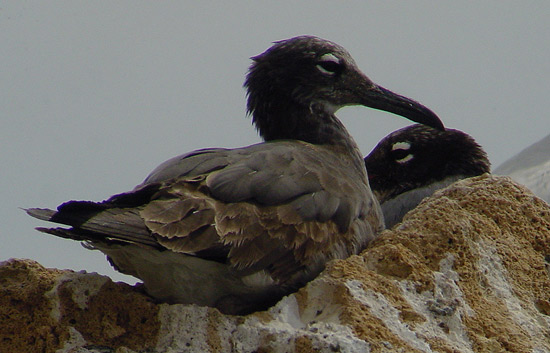 White-eyed Gull (L. leucophthalmus)
& Sooty Gull (L. hemprichii)
White-eyed Gull (L. leucophthalmus)
& Sooty Gull (L. hemprichii)
(last update:
White-eyed Gull L. leucophthalmus 2CY, February 22 2002, Shark Bay - Sharm El Sheik, S Sinai, Egypt.
Compared to Sooty Gull, which is the only likely confusing species,
White-eyed Gull has a longer, thinner and slimmer bill, appearing all dark from
a distance and clearly lacking the two-toned billed of Sooty Gull. White-eyed
Gull is smaller in size and especially more elegantly build; lacking the high
breast and strong neck of Sooty Gull. White-eyed Gull, as the name suggests, has
two white crescents in all plumages and especially the upper crescent is very
obvious, while this is only a small crescent in Sooty Gull. The lower
crescent is often completely lacking in Sooty Gull.
In fresh juvenile plumage, Sooty Gull is more contrastingly patterned than
White-eyed Gull. The coverts, tertials and scapulars show buffish brown fringes. By
February (late winter) these fringes are less obvious as the scapulars are
moulted to second generation feathers, while the tertials and wing-coverts are strongly bleached
and abraded, lacking the pale tips in both species. The post-juvenile takes
place from probably June to December, depending on fledging date in particular
populations. First winter birds are often described in publications as
"resembling juveniles but with moulted body and head feathers, scapulars
and mantle". However, first winter birds including some wing-coverts in
this post-juvenile moult might actually be quite common.
The pointed juvenile primaries are bleached brown-black and by February the tips are worn, leaving a protruding shaft of p10, as can be seen in the picture. All juvenile rectrices are pale brown. The juvenile tertials have the same brown colour as the tail-feathers; they are brown centred with the pale fringe worn away. A variable amount of wing-coverts are moulted in first winter plumage, depending on the fledging date. In the greater coverts, the visible outer feathers has been replaced. In the left wing greater covert #5 has been replaced as well. In the central median coverts #12-13 have been moulted to second generation. The scapulars and mantle feathers were moulted already in last autumn. The first moulted feathers already appear bleached and the fringes worn. As can be seen in the picture, the lowest row of lower scapulars have been moulted last, still grey without a brown hue. Head and body feathers appear very abraded and partial spring moult will probably soon start. The legs are pale pinkish and the bill is all dark.
